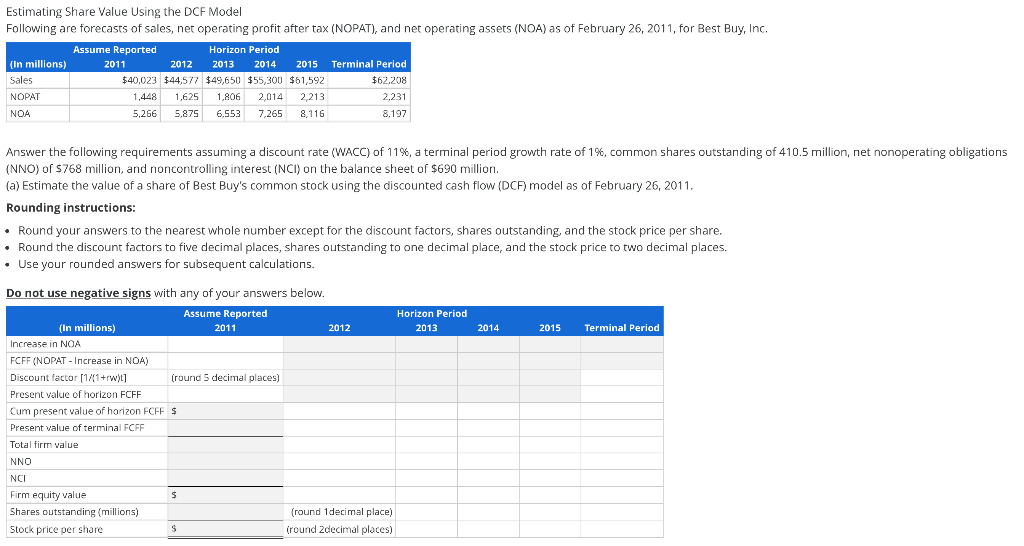
Estimating Share Value Using the DCF Model Following are forecasts of sales, net operating profit after tax (NOPAT), and net operating assets (NOA) as of February 26, 2011, for Best Buy, Inc. Assume Reported Horizon Period (In millions) 2011 2012 2013 2014 2015 Terminal Period Sales $40,023 $44,577 $49,650 $55,300 $61,592 $62,208 NOPAT 1,448 1,625 1,806 2,014 2,213 2,231 NOA 5,266 5.875 6,553 7,265 8,116 8,197 Answer the following requirements assuming a discount rate (WACC) of 11%, a terminal period growth rate of 1%, common shares outstanding of 410.5 million, net nonoperating obligations (NNO) of $768 million, and noncontrolling interest (NCI) on the balance sheet of $690 million. (a) Estimate the value of a share of Best Buy's common stock using the discounted cash flow (DCF) model as of February 26, 2011. Rounding instructions: Round your answers to the nearest whole number except for the discount factors, shares outstanding, and the stock price per share. Round the discount factors to five decimal places, shares outstanding to one decimal place, and the stock price to two decimal places. Use your rounded answers for subsequent calculations. 2014 2015 Terminal Period Do not use negative signs with any of your answers below. Assume Reported Horizon Period (In millions) 2011 2012 2013 Increase in NOA FCFF (NOPAT - Increase in NOA) Discount factor (1/(1+rw)t] (round 5 decimal places) Present value of horizon FCFF Cum present value of horizon FCFF $ Present value of terminal FCFF Total firm value NNO NCI Firm equity value Shares outstanding (millions) (round 1decimal place) Stock price per share S (round 2decimal places) Estimating Share Value Using the DCF Model Following are forecasts of sales, net operating profit after tax (NOPAT), and net operating assets (NOA) as of February 26, 2011, for Best Buy, Inc. Assume Reported Horizon Period (In millions) 2011 2012 2013 2014 2015 Terminal Period Sales $40,023 $44,577 $49,650 $55,300 $61,592 $62,208 NOPAT 1,448 1,625 1,806 2,014 2,213 2,231 NOA 5,266 5.875 6,553 7,265 8,116 8,197 Answer the following requirements assuming a discount rate (WACC) of 11%, a terminal period growth rate of 1%, common shares outstanding of 410.5 million, net nonoperating obligations (NNO) of $768 million, and noncontrolling interest (NCI) on the balance sheet of $690 million. (a) Estimate the value of a share of Best Buy's common stock using the discounted cash flow (DCF) model as of February 26, 2011. Rounding instructions: Round your answers to the nearest whole number except for the discount factors, shares outstanding, and the stock price per share. Round the discount factors to five decimal places, shares outstanding to one decimal place, and the stock price to two decimal places. Use your rounded answers for subsequent calculations. 2014 2015 Terminal Period Do not use negative signs with any of your answers below. Assume Reported Horizon Period (In millions) 2011 2012 2013 Increase in NOA FCFF (NOPAT - Increase in NOA) Discount factor (1/(1+rw)t] (round 5 decimal places) Present value of horizon FCFF Cum present value of horizon FCFF $ Present value of terminal FCFF Total firm value NNO NCI Firm equity value Shares outstanding (millions) (round 1decimal place) Stock price per share S (round 2decimal places)







